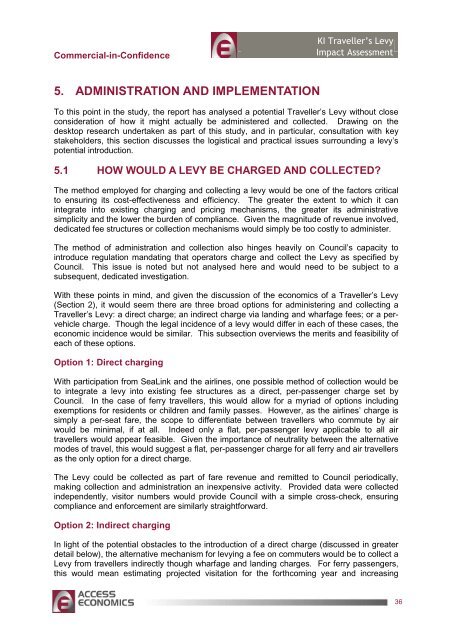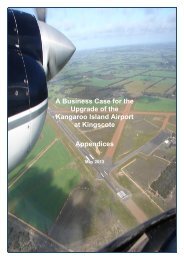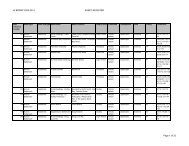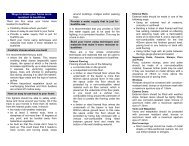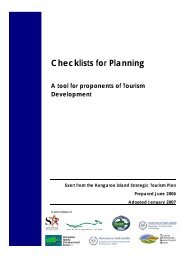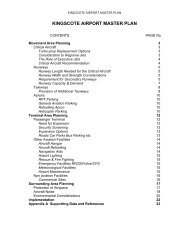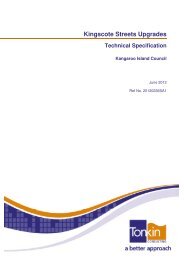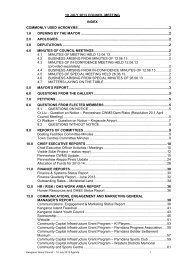KI Traveller's Levy Economic Impact Assessment - Kangaroo Island ...
KI Traveller's Levy Economic Impact Assessment - Kangaroo Island ...
KI Traveller's Levy Economic Impact Assessment - Kangaroo Island ...
Create successful ePaper yourself
Turn your PDF publications into a flip-book with our unique Google optimized e-Paper software.
Commercial-in-Confidence<br />
<strong>KI</strong> Traveller’s <strong>Levy</strong><br />
<strong>Impact</strong> <strong>Assessment</strong><br />
5. ADMINISTRATION AND IMPLEMENTATION<br />
To this point in the study, the report has analysed a potential Traveller’s <strong>Levy</strong> without close<br />
consideration of how it might actually be administered and collected. Drawing on the<br />
desktop research undertaken as part of this study, and in particular, consultation with key<br />
stakeholders, this section discusses the logistical and practical issues surrounding a levy’s<br />
potential introduction.<br />
5.1 HOW WOULD A LEVY BE CHARGED AND COLLECTED<br />
The method employed for charging and collecting a levy would be one of the factors critical<br />
to ensuring its cost-effectiveness and efficiency. The greater the extent to which it can<br />
integrate into existing charging and pricing mechanisms, the greater its administrative<br />
simplicity and the lower the burden of compliance. Given the magnitude of revenue involved,<br />
dedicated fee structures or collection mechanisms would simply be too costly to administer.<br />
The method of administration and collection also hinges heavily on Council’s capacity to<br />
introduce regulation mandating that operators charge and collect the <strong>Levy</strong> as specified by<br />
Council. This issue is noted but not analysed here and would need to be subject to a<br />
subsequent, dedicated investigation.<br />
With these points in mind, and given the discussion of the economics of a Traveller’s <strong>Levy</strong><br />
(Section 2), it would seem there are three broad options for administering and collecting a<br />
Traveller’s <strong>Levy</strong>: a direct charge; an indirect charge via landing and wharfage fees; or a pervehicle<br />
charge. Though the legal incidence of a levy would differ in each of these cases, the<br />
economic incidence would be similar. This subsection overviews the merits and feasibility of<br />
each of these options.<br />
Option 1: Direct charging<br />
With participation from SeaLink and the airlines, one possible method of collection would be<br />
to integrate a levy into existing fee structures as a direct, per-passenger charge set by<br />
Council. In the case of ferry travellers, this would allow for a myriad of options including<br />
exemptions for residents or children and family passes. However, as the airlines’ charge is<br />
simply a per-seat fare, the scope to differentiate between travellers who commute by air<br />
would be minimal, if at all. Indeed only a flat, per-passenger levy applicable to all air<br />
travellers would appear feasible. Given the importance of neutrality between the alternative<br />
modes of travel, this would suggest a flat, per-passenger charge for all ferry and air travellers<br />
as the only option for a direct charge.<br />
The <strong>Levy</strong> could be collected as part of fare revenue and remitted to Council periodically,<br />
making collection and administration an inexpensive activity. Provided data were collected<br />
independently, visitor numbers would provide Council with a simple cross-check, ensuring<br />
compliance and enforcement are similarly straightforward.<br />
Option 2: Indirect charging<br />
In light of the potential obstacles to the introduction of a direct charge (discussed in greater<br />
detail below), the alternative mechanism for levying a fee on commuters would be to collect a<br />
<strong>Levy</strong> from travellers indirectly though wharfage and landing charges. For ferry passengers,<br />
this would mean estimating projected visitation for the forthcoming year and increasing<br />
36


